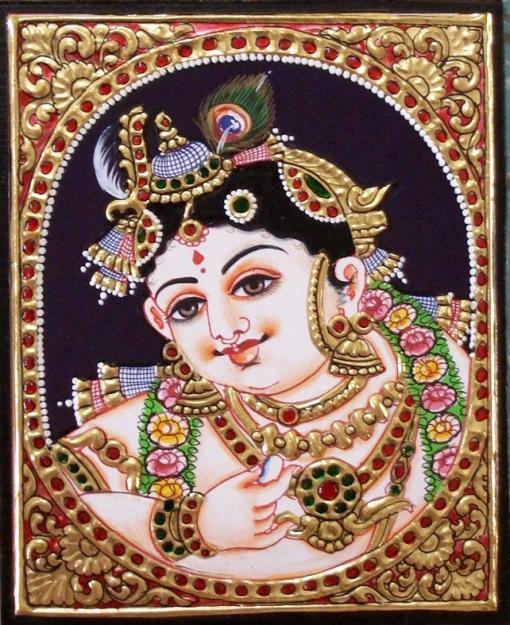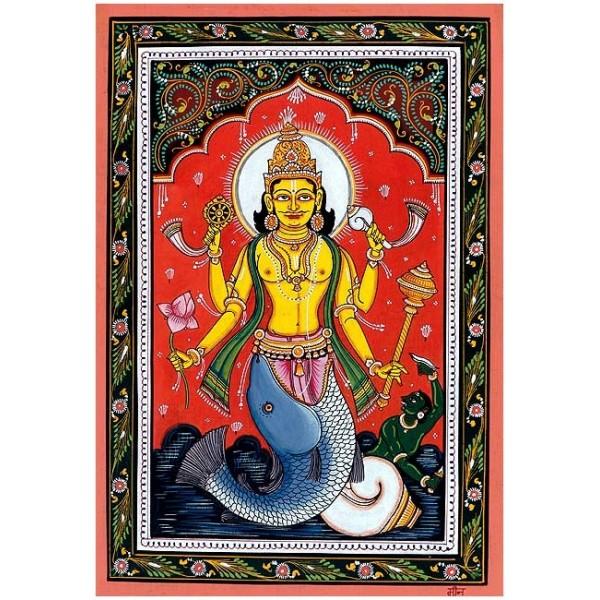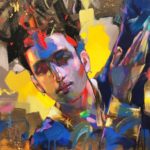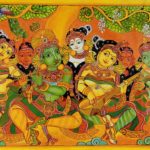Ancient Indian folk painting and art styles have been passed down from generation to generation, and are still practised in different parts of the country. Here’s a look at what makes 10 of these folk art forms unique. Passed down from one generation to another, Indian folk art is still alive in many parts of the country. Being culturally diverse and distinct, a variety of art forms have evolved over the years; some untouched by modernisation, some adapting to new paint colours and materials.
Each depicts religious epics or Gods and Goddesses mostly, but they’re all unique, admirable and inimitable in their own might. In the days of yore, they were made with natural dyes and colours made of soil, mud, leaves and charcoal, on canvas or cloth giving it a sense of antiquity, vintage nostalgia.
Madhubani
Also called Mithila art, it originated in the kingdom of Janak (Sita’s father in Ramayana) in Nepal and in present-day Bihar. It is one of the most popular Indian folk arts, practised mostly by women who wanted to be one with God. Characterised by geometric patterns, this art form wasn’t known to the outside world until the British discovered it after an earthquake in 1930’s revealed broken houses with Madhubani paintings. It mirrored the work of Picasso and Miro, according to William G. Archer. Most of these paintings or wall murals depict gods, flora and fauna.

Madhubani
Miniature Paintings
These paintings are characterised by its miniature size but intricate details and acute expressions. Originating in the Mughal era, around 16th century, Miniature paintings are influenced by Persian styles, and flourished under Shah Jahan and Akbar’s rule. Later, it was adopted by Rajputs, and is now popularly practiced in Rajasthan. As with other art forms, the paintings depict religious symbols and epics. These paintings stand out as humans are portrayed with large eyes, a pointed nose and a slim waist, and men are always seen with a turban.

Miniature Paintings
Phad
Originating in Rajasthan, Phad is mainly a religious form of scroll painting depicting folk deities Pabuji or Devnarayan. The 30- or 15 feet-long canvas or cloth that it is painted on is called phad. Vegetable colours and a running narrative of the lives and heroic deeds of deities characterise these paintings.

Phad
Warli
Originated by the Warli tribes from the Western Ghat of India, in 2500 BCE, this is easily one of the oldest art forms of India. It is mainly the use of circles, triangles and squares to form numerous shapes and depict daily life activities like fishing, hunting, festivals, dance and more. What sets it apart is the human shape: a circle and two triangles. All the paintings are done on a red ochre or dark background, while the shapes are white in colour.

Warli
Gond
Characterised by a sense of belonging with nature, the Gondi tribe in Madhya Pradesh created these bold, vibrantly coloured paintings, depicting mainly flora and fauna. The colours come from charcoal, cow dung, leaves and coloured soil. If you look closely, it is made up of dots and lines. Today, these styles are imitated, but with acrylic paints. It can be called an evolution in the Gond art form, spearheaded by Jangarh Singh Shyam, the most popular Gond artist who revived the art for the world in the 1960’s.

Gond
Kalamkari
Literally meaning ‘drawings with a pen’, Kalamkari is of two types in India: Machilipatnam, which originates from Machilipatnam in Andhra Pradesh and Srikalahasti, which originates from Chitoor in the same state. While the former refers to block-printed form of art, the latter is a free flowing art with a pen on fabric. Today, Kalamkari art is used on sarees and ethnic clothing, and depicts anything from flora and fauna to epics such as Mahabharata or Ramayana.

Tanjore
From down South, Tanjore or Thanjavur paintings originated in 1600 AD, encouraged by the Nayaks of Thanjavur. You can recognise a Thanjavur painting by its use of gold foil, which glitters and lends the painting a surreal look. These panel paintings on wooden planks depict devotion to gods, goddesses and saints. It borrows its styles from Maratha and Deccani art, as well as European styles.

Cheriyal Scrolls
Originating in present-day Telangana, this dying art form is practised by the Nakashi family only, where it has been passed down for many generations. The tradition of long scrolls and Kalamkari art influenced the Cheriyal scrolls, a much more stylised version of Nakashi art. Depicting puranas and epics, these 40-45 feet scrolls were an essential visual accompaniment as saints wandered around singing or narrating the epics. They resemble modern-day comic panels, with about 50 on each scroll. They use primary colours and a vivid imagination, a stark contrast from the traditional rigour of Tanjore or Mysore paintings.

Kalighat Paintings
A recently discovered painting style, it originated in the 19th century Bengal, from Kalighat. It was the time when upheaval against the British was a possible, exciting idea. These paintings, on cloth and pattas, at first depicted Gods and Goddesses, but then took a turn towards social reform. With cheap paper and paint colours, squirrel hair brushes and colour pigments, the art was characterised by flawless strokes, brushwork, and simple but bold drawings. It sought to raise awareness about social conditions in its viewers – rich zamindars were depicted drinking wine with women, while priests were shown with ‘unchaste’ women and police babus being sloppy.

Patachitra
A cloth-based scroll painting from Odisha and West Bengal, these paintings with sharp, angular bold lines depict epics, Gods and Goddesses. Originating from the fifth century in religious hubs like Puri and Konark, around the same time that sculpting began, considering there was no known distinction between an artist and sculptor back then. What’s unique about this art form is that the dress style depicted in the paintings has heavy influence of the Mughal era.

These traditional Art forms of India are currently being recognized worldwide as well.



What do you think?